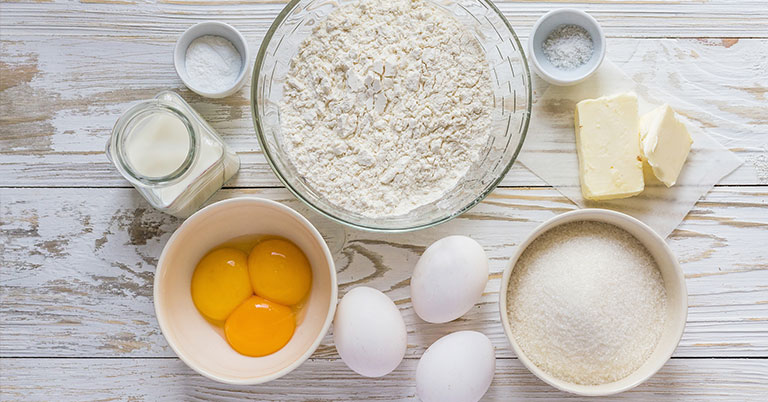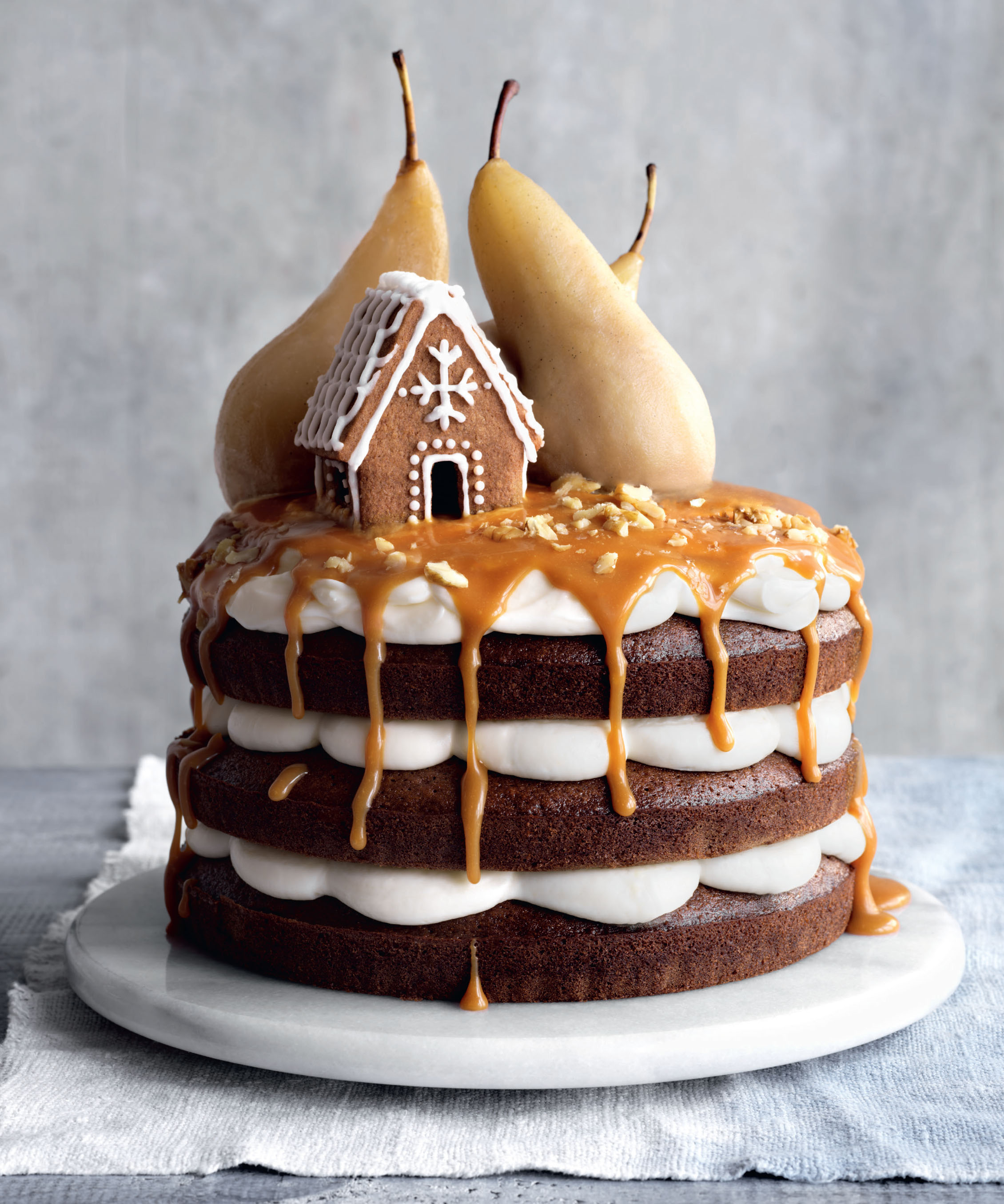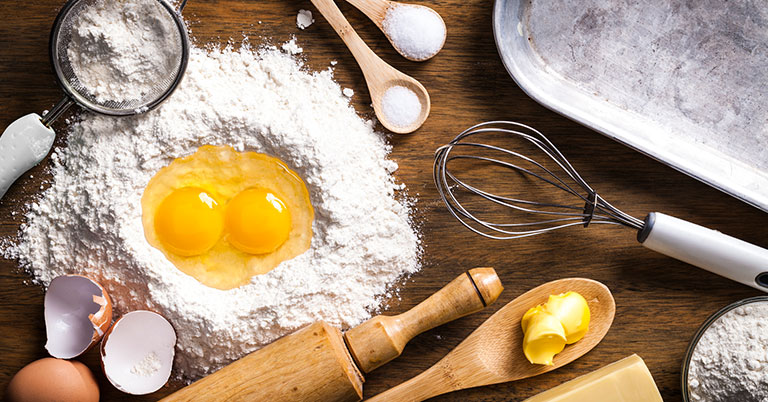Stem Ginger Cake with Cream-cheese Frosting & Salted Caramel Recipe from The Great British Bake Off: Get Baking for Friends and Family

Stem Ginger cake laced with crystallised stem ginger, drizzled with salted caramel and topped with pears and
a little gingerbread house!
Serves 12
 For the poached pears
For the poached pears
3 conference pears,
peeled, stem intact
40g dark muscovado sugar
1 star anise
2 pieces cinnamon bark
1 tbsp vanilla paste
3 green cardamom pods
For the sponge
250g slightly salted butter
250g dark muscovado sugar
120g treacle
375g plain flour
1 tbsp ground cinnamon
4 tbsp ground ginger
300ml whole milk
2 tsp bicarbonate of soda
3 eggs, beaten
100g crystallised ginger, roughly chopped
For the salted caramel
120g caster sugar
115ml double cream
1/2 tsp salt
For the biscuit dough
75g slightly salted butter
50g dark muscovado sugar
1 tsp molasses
11/2 tbsp beaten egg
110g plain flour
1/4 tsp bicarbonate of soda
3/4 tsp ground cinnamon
1 tbsp ground ginger
1 boiled sweet, crushed
For the frosting
100g unsalted butter,
at room temperature
280g full-fat cream cheese
600g icing sugar
100g walnuts, chopped
For the royal icing
2 tbsp pasteurised egg white
100g icing sugar
You will need
18cm round cake tins x 3, greased, then base-lined with baking paper; baking sheet lined with baking paper; large disposable piping bag;
small piping bag fitted with a No.1 writing nozzle
Step 1
For the poached pears, place the pears in a medium pan. Add the sugar, star anise, cinnamon, vanilla and cardamom, then add enough water to cover the pears. Place over a high heat and bring to the boil. Reduce the heat to low and simmer for 20 minutes, until the pears are tender but not soft. Remove from the heat, drain and leave the pears to cool. When cold, trim the bases so the pears stand up.
Step 2
For the sponges, heat the oven to 180°C/160°C fan/350°F/Gas 4. Put the butter, sugar and treacle into a medium pan over a medium heat. Stir until the sugar has dissolved, then remove from the heat and set aside.
Step 3
In a separate bowl, sift the flour, cinnamon and ginger together. Heat the milk in a small pan over a low heat until lukewarm. Remove from the heat, add the bicarbonate of soda and whisk until foamy.
Step 4
Pour the warm butter mixture over the flour mixture and whisk together. Add the eggs and crystallised ginger, then whisk in the milk until smooth and just combined.
Step 5
Immediately divide the mixture equally between the 3 lined tins and level with a palette knife. Bake for 25–35 minutes, until risen and a skewer inserted into the centre comes out clean. Remove from the oven and cool in the tins for 5 minutes, then turn out onto a wire rack to cool completely.
Step 6
For the salted caramel, put the sugar in a medium pan. Add 3 tablespoons of water and stir with your fingers until the mixture feels like wet sand. Place over a medium heat and cook, without stirring, to dissolve the sugar.
Step 7
Increase the heat and boil to an amber caramel, swirling the pan occasionally. Do not stir. Remove from the heat and whisk in the cream (take care – it might splatter). Add the salt, then set aside to cool. Once cool, refrigerate until cold.
Step 8
Make the biscuit dough. Put the butter, sugar and molasses in a stand mixer fitted with the beater. Cream together until smooth. Add the egg and combine. Add the flour, bicarbonate of soda, cinnamon and ginger and mix with a wooden spoon to form a soft dough. Wrap in cling film and chill for 20 minutes.
Step 9
Heat the oven to 190°C/170°C fan/375°F/Gas 5. Roll out the gingerbread dough on a lightly floured surface to ½cm thick.
Step 10
Cut out shapes to make a ginger biscuit house (2 ends, 2 side walls, and 2 roof sides), measuring 4cm wide and 6cm high in total. Cut out a window and a door shape in one of the ends, then place all the house pieces on the lined baking sheet. Spoon the crushed boiled sweet in the window to make a pane.
Step 11
Bake the biscuits for 6–8 minutes, until cooked through. Remove from the oven and, using the baking paper, slide onto a wire rack to cool and harden.
Step 12
For the frosting, beat the butter and cream cheese together until just incorporated, then beat in the icing sugar until just thick and smooth. Spoon into a large disposable piping bag and snip to make a 2cm diameter hole in the end.
Step 13
For the royal icing, lightly whisk the egg white until frothy. Then, add the icing sugar, a little at a time, stirring continuously with a wooden spoon, until you reach a piping consistency.
Step 14
Spoon into a small piping bag fitted with a No.1 writing nozzle. When the biscuits are cooled, assemble the house using the royal icing as glue. Then, pipe an outline around the
window and door, and pipe roof tiles on the top.
Step 15
To assemble the cake, trim the sponges until level. Place one sponge on a cake stand and pipe over ¹⁄³ of the frosting and sprinkle over ½ of the walnuts. Place the second sponge on top and pipe over another ¹⁄³ of the frosting and sprinkle over most of the remaining walnuts, reserving a few for the top.
Step 16
Place the last sponge on top and spread the top of the cake with the remaining frosting. Spoon some caramel over the frosting and smooth over with a palette knife, allowing some to drip down the sides. Arrange the pears and the biscuit house on top and sprinkle around the reserved walnuts to finish.
This recipe has been taken from The Great British Bake Off: Get Baking for Friends and Family
THE SERIES 9 TIE-IN BOOK
More than 100 beautiful and mouth-watering sweet and savoury bakes, from Paul Hollywood, Prue Leith and all the series 8 and 9 bakers.
As well as helpful hints, tips and tricks, and easy step-by-step instructions and photographs throughout.
On your marks, get set, BAKE!
The Great British Bake Off: Get Baking for Friends & Family will encourage and empower amateur bakers of all abilities to have a go at home, taking inspiration from The Great British Bake Off's most ambitious bakes but with simplified recipes and straightforward instructions that will enable even complete beginners to impress their nearest and dearest.
From children's birthdays and charity bake sales to celebrating with a loved one or simply enjoying sweet treat over a cup of tea and a catch-up with a dear friend, Get Baking for Friends & Family is a celebration of all those shared moments: both in the joy of making and in the simple pleasure of indulging in something really delicious.
What readers are saying:
'Gorgeous! This is the most lovely GBBO book I've got. Photos are beautiful and I am so pleased that the instructions are shorter than previous books.'
'Beautiful photography and has motivated me to dust off the oven gloves immediately as well as providing a perfect companion to this year's Bake Off.'
'So many excellent recipes, both classic and more innovative too. I can't wait to give this as a gift this Christmas.'
'Heartily recommend the book to aspiring and improving bakers.'
'Very well written, easy to follow, and also looks great on my coffee table which is a bonus. Most importantly I want to eat all the things in the book, which is what I look for in a cookbook!'
'The recipes are all 5 star for me so far.'







